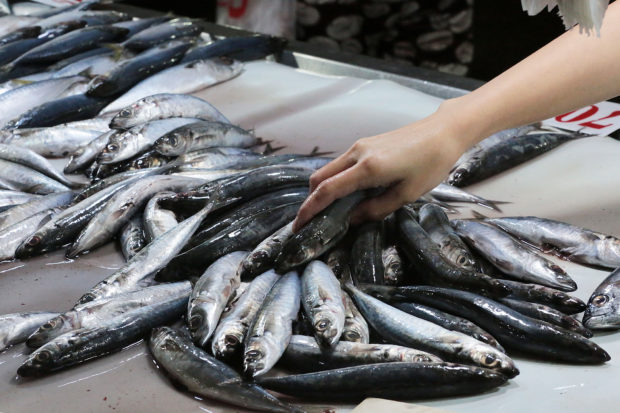Answer to inflation threat: More imported pork, fish

LOCALLY SOURCED / AUGUST 22, 2018
A fish vendor at Commonwealth Market in Quezon City arranges locally sourced “galunggong” or round scad to entice customers to buy on Wednesday, August 22, 2018. The Department of Agriculture (DA) has allowed the importation of “galunggong” to address the rising prices of the fish variety in the market. A group of fisherfolks are protesting the importation of the said variety of fish.
INQUIRER PHOTO / GRIG C. MONTEGRANDE
MANILA, Philippines—Short supply of food items like pork, fish and corn would add to upward inflation pressures aggravated by expensive oil wrought by Russia’s invasion of Ukraine, the state planning agency National Economic and Development Authority (Neda) said.
In a report on Monday, Neda said that as of early April, projections showed that Dubai crude oil prices would likely ease from $110.9 per barrel last March to $103.7 a barrel in May, and further down to $92 per barrel by yearend. “As oil prices remain elevated and highly volatile, government measures to cushion price pressures remain proactive,” Neda said, referring to the total of P47.5 billion in aid for
sectors worst hit by costly fuel.
“As of March 23, around 115,000 PUV [public utility vehicle] drivers and operators have already received their P6,500 subsidy each under the Pantawid Pasada program. A second tranche is expected to be distributed in April,” Neda said.
It added that the Department of Budget and Management (DBM) also released P7 billion to the Department of Transportation (DOTr) for the PUV service contracting program, or “Libreng Sakay”.
Also, Neda said that “more than 158,000 corn farmers and fisherfolk registered under the registry system for basic sectors in agriculture are also set to receive P3,000 as fuel subsidy.”
Article continues after this advertisementWhile the government tackles expensive fuel, Neda said projected shortages in supply of some food products may hike prices this year.
Article continues after this advertisementNeda said that while rice and chicken inventories, as well as highland vegetable supply, would post surpluses against this year’s demand, “deficits are expected for lowland vegetables, pork, fish, and corn.”
“For lowland vegetables, the local production outlook is expected at 1.3 million metric tons (MT) for 2022, or only 80.2 percent of local demand,” Neda said.
“Similarly, the pork supply deficit is estimated at 197,600 MT, despite the arrival of imports under Executive Order (EO) Nos. 133 and 134. The pork minimum access volume (MAV) plus remained underutilized — out of 200,000 MT, less than 40 percent has been used,” Neda said.
“A fish supply deficit for the entire year is expected due to a faster increase in demand. The indirect impact of the Russia-Ukraine conflict through higher international prices of wheat and corn will partly contribute to the corn supply deficit for the marketing year 2021-2022, even after considering alternative feed supplies such as cassava,” Neda added.
While the Tariff Commission already started to investigate if EOs 133 and 134—prolonging lower pork import tariffs at a higher quota until end-2022—would be feasible, Neda said “more timely unloading of pork stocks from cold storage is needed.”
“As of the fourth week of March, the average stock of frozen pork has been continuously decreasing since November 2021 but remains higher than in 2019,” Neda said.
Last month, Socioeconomic Planning Secretary and Neda chief Karl Kendrick Chua urged President Rodrigo Duterte to extend until December 2022 the pork tariff rates of 15 percent in-quota and 25 percent out-quota under the MAV plus.
On fish, Neda urged the Department of Agriculture (DA) to “facilitate the immediate distribution of imported fish under the CNI [certificate of necessity to import] for the fourth quarter of 2021 to the first quarter of 2022, and consider the additional issuance of CNI for the second to fourth quarters” of this year.
Neda noted that the Bangko Sentral ng Pilipinas (BSP) now expects headline inflation to average 4.3 percent in 2022 — above the 2 to 4 percent target band of manageable price hikes conducive to economic growth, on the back of “the impact of higher global commodity prices and a shortage in domestic supplies of pork and fish.”